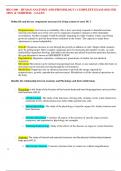BIO 1100 – HUMAN ANATOMY AND PHYSIOLOGY 1 COMPLETE EXAM (SOLVED
100% & VERIFIED) - GALEN
Define life and the key components necessary for living systems to exist: PG 3
- Responsiveness: also known as irritability, this is how your body responds to harmful reactions
(moving your hand away from a hot stove) organisms respond to changes in their immediate
environment. Another example would be animals migrating in colder weather, winter coats being
grown by animals to provide them better insulation in the winter. The capacity to make these
adjustments is termed adaptability.
- Growth: Organisms increase in size through the growth or addition of cells. Single celled creatures
grow by getting larger. More complex organisms grow by increasing the number of cells. As such
multicellular organisms develop, individual cells become specialized to perform particular functions,
this specialization is known as DIFFERENTATION.
- Reproduction: Organisms reproduce, creating new generations of similar, but not identical
organisms.
- Movement: Movement can be internal (transporting food, blood, or any materials within the body) or
movement can be external (moving through the environment)
- Metabolism: Organisms rely on chemical reactions to provide the energy required for
responsiveness, growth, reproduction and movement. Metabolism is all the chemical operations in
the body.
Identify the relationship between Anatomy and Physiology and their subdivisions
- Physiology is the Study of the function of the human body and how living organisms carry out their
vital functions. (PG 4)
o Cell physiology- The study of the functions of living cells, includes events at the chemical or
molecular levels, chemical processes both within and between cells.
o Special physiology- The study of the physiology of specific organs (Ex: kidney function and
heart function)
o Systemic physiology- Considers all aspects of the function of specific organ systems,
respiratory and reproductive physiology are examples.
o Pathological physiology- Study of the effects of the diseases on organ or system functions.
- Anatomy: The study of internal and external structures and the physical relationships between
body parts (PG 3)
o Microscopic Anatomy- Concerns structures that we cannot see without magnification.
1
, o Cytology- Analyzes the internal structure of individual cells.
o Histology- Examines tissues, groups of specialized cells and cell products that work together
to carry out specific functions.
o Gross Anatomy- (Macroscopic anatomy) considers features visible with the unaided eye.
o Surface Anatomy- The study of general form and superficial markings.
o Regional Anatomy- Considers all the superficial and internal features in a specific region of
the body, such as the head, neck, or trunk.
o Systemic Anatomy- Considers the structures of major organ systems, which are groups of
organs that work together. For example, the heart, blood, and blood vessels form the
cardiovascular system, which circulates oxygen and nutrients to the body.
o Developmental Anatomy- the field of embryology concerned with the changes that cells,
tissue, organs and the body as a whole undergo from a germ cell of each parent to the
resulting offspring, it includes both prenatal and postnatal development. (The study of the
process by which organisms grow and develop)
Differentiate the levels of structural organization of the human body
- Chemical level- Atoms the smallest stable units of matter, combine to form molecules, a molecules
shape determines its function.
- Cellular level- Cells, the smallest living units in the body.
- Tissue level- Tissue is composed of similar cells working together to perform a specific function.
o Epithelial- Widespread throughout body, form the covering of all body surfaces, line body
cavities and hollow organs. FX: protection, secretion, absorption, excretion, filtration, sensory
reception, diffusion.
o Connective- Supports, protects and gives structure to other tissues and organs in the body, stores
fats, helps move nutrients, and helps repair damaged tissue.
o Muscular- Composes muscles in animal bodies and gives rise to muscles ability to contract in
order to produce movement of the body parts.
o Nervous- found in the brain, spinal cord and nerves. Stimulates muscle contraction, creates
awareness of environment, and plays a major role in emotions, memory and reasoning.
- Organ level- An organ consists of two or more different tissues working together to perform a specific
function. An example of the organ level is the heart.
2




